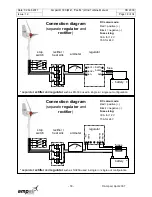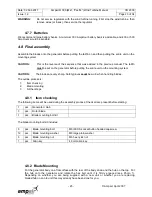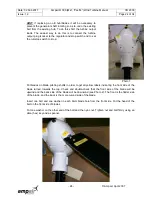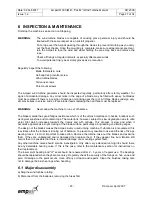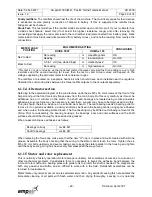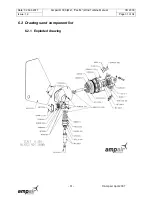
Date: 02 Feb 2011
Ampair ® 300 (Mk1, “Pacific”) Wind Turbine Manual
CD 2300
Issue: 1.2
Page 27 of 34
- 27 -
© Ampair, April 2007
6 INSPECTION & MAINTENANCE
First stop the machine, see section on Stopping.
WARNING:
The wind turbine blades are capable of causing grave personal injury and should be
treated with the same respect as an aircraft propeller.
Put a rope over the Ampair passing through the blades to prevent its turning as you carry
out the final checks. Once the mounting is complete, make sure all personnel are clear,
turn the Ampair to face the wind and whilst holding the vane step back and remove the
rope.
Check all fixings at regular intervals, especially after severe winds.
To avoid personal injury wear sturdy gloves as a precaution.
Regularly inspect the following:
Blade fasteners & nuts
Hub cap fixing (centre) screw
Wind turbine blades
Tail vane screws
Pole mount screws
The Ampair wind turbine generator should be inspected regularly, particularly after stormy weather, for
signs of accidental damage. Any minor nicks in the edge of a blade may be filled with epoxy, but blades
must be replaced if there is any sign of damage or cracking near the root. All three blades undergo very
similar stresses in service and so if one blade needs replacing then all three must be replaced.
WARNING:
Never allow the machine to run out of balance.
The blade material has good fatigue resistance which is of the utmost importance in hostile locations such
as tropical sunshine and mountain tops. The material is, however, subject to slow degradation due to ultra
violet light which increases towards the tropics and with altitude. This process is slow and when it
becomes apparent as a slight crazing of the blade surface, particularly along leading and trailing edges.
The design of the blades makes the Ampair a very quiet running machine. If vibration is encountered, this
is evidence that the turbine is running out of balance. To prevent any resultant noise and the risk of fixings
working loose, it is most important to take action. Remove the turbine, take out the blades and examine
them. If they are unbalanced and/or damaged then replace them. If they appear fine but vibration still
occurs then it is possible that there is internal damage or a mounting system fault.
Any other machine noise should also be investigated. Only after very extended running life should there
be any detectable bearing noise. If this is the case, refer to the maintenance section for instructions on
their replacement.
The lower pivot bearing and "O" seal should be renewed after 2 - 3 years of regular use. The bearings
should be replaced when they become noisy. Regularly check the security of the fixings on hub, vane and
pole. If damage to the paint occurs, clean off any corrosion and repaint. Clean the brushes, taking care
not to damage the brush springs when handling.
6.1 Major disassembly
a) Stop the wind turbine rotating.
b) Disconnect from the batteries, removing the fuses first.






